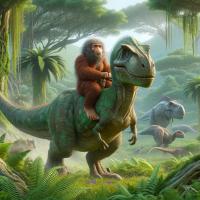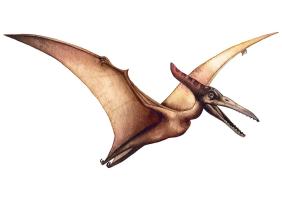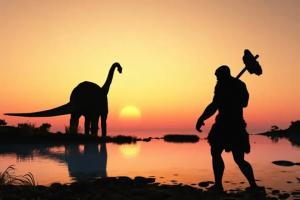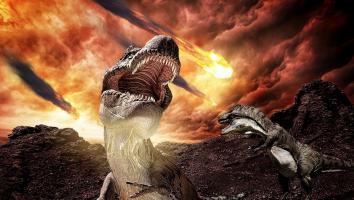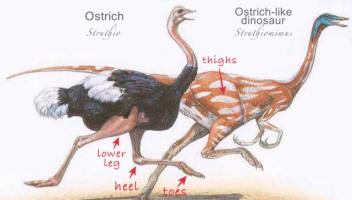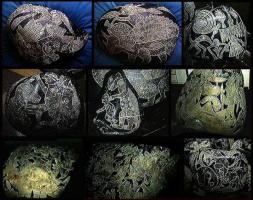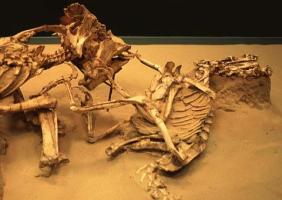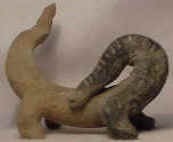Italian dinosaurs
The Alta Valcellina is still, for the most part, uncontaminated and wild, thanks also to the protection offered by its bold peaks which jealously guard a suggestive and highly interesting landscape and flora-faunistic heritage such as, for example, that of the Val di Giere, in which a fragment of a Dinosaur track was discovered which left its footprint, visible to the naked eye, imprinted on a rock beneath a waterfall.
An interesting site near Col Pilusel and the Rio di Casavento waterfall (Ciol de Ciasavent).
The boulder, which fell from the rock face above, was part of a trail followed by a bipedal dinosaur dating back to around 215 million years ago, when birds did not yet exist. Almost in the center of the surface of the boulder, a complete imprint made by the right hind paw is clearly visible, while another, partially preserved on the edge of the boulder, belongs to the left one. It is necessary to wait for grazing sunlight to observe those finds because the footprints are not very deep and therefore it is not possible to notice the nuances created by the shadows of the bulges if the Sun sends its rays perpendicularly onto the boulder.
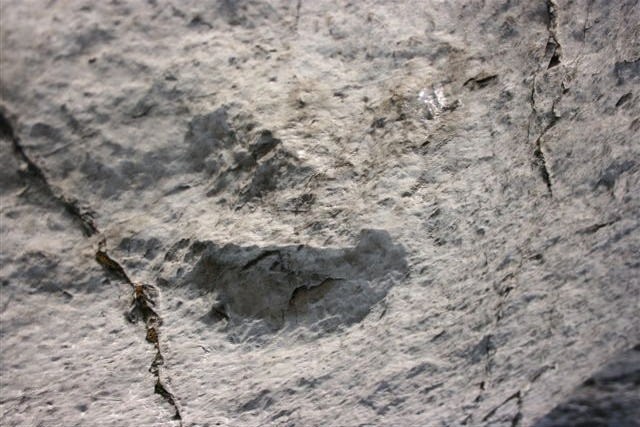
The three-toed footprint of a theropod, 35 centimeters long, can clearly be seen, with an external bulge representing the mud expelled laterally from the animal's foot due to its weight. The fingers are thin and elongated and the middle finger appears to be slightly longer than the other two.
- JURASSIC: the second of the three geological periods into which the Mesozoic era and what belongs to it is divided.
- PERMIAN: last period of the Paleozoic geological era and everything that refers to it.
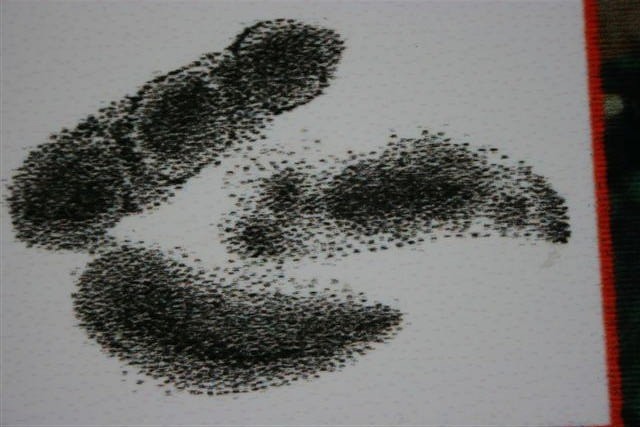
Dinosaurs are a group of reptiles of various sizes, known only through fossil remains studied and found in excavations carried out by paleontologists and more recently also by collectors.
The first dinosaur was discovered in the 19th century. It was a gigantic reptile that appeared approximately 230 million years ago: it had a stocky and robust trunk, small head, four legs and a long and strong tail.
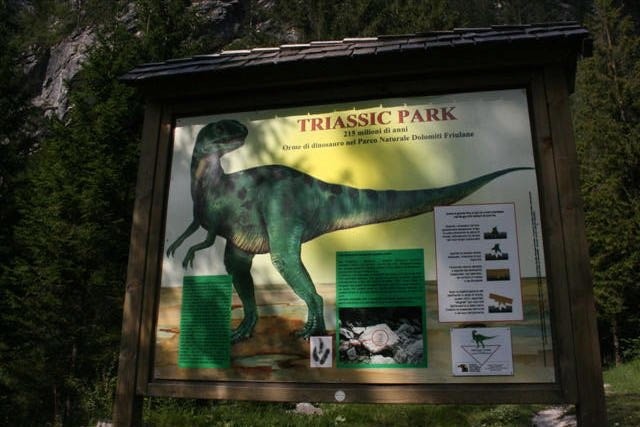
Dinosaurs appeared between the end of the Middle Triassic and the beginning of the Upper Triassic, that is, between the Jurassic period and the end of the Cretaceous period, about 20 million years after the end of the Permian-Triassic. This enormous change caused the disappearance of approximately 70 percent of all biological diversity on the planet.
Dinosaurs belonged to the subclass of Archosaurs, which dominated the terrestrial ecosystem for over 165 million years, becoming completely extinct about 65 million years ago, at the end of the Cretaceous period.
The superorder or clade "Dinosauria" was so named in 1842 by the English scientist Richard Owen, to express respect for the size and majesty of these animals. [Etymologically the name comes from the Latin Dinosaurus and from the Greek: deinòs 'terrible' and sauròs 'lizard'.]
The Tyrannosauridae, an enormous bipedal animal, among the largest carnivores that ever existed in the Cretaceous period, also belonged to the superorder of Dinosaurs.
Tyrannosaurids were theropod dinosaurs of the tetanur family, direct descendants of the small Coelurosaurs of the Jurassic.
Giant coelurosaurs were predators, but some paleontologists believe that larger species, such as Tyrannosaurus rex, were carrion eaters. Scientists in the past believed that due to their large size, tyrannosaurids were part of the large carnosaurs, but more recent studies, based mainly on the bones of the skull and legs, place them in common with smaller carnivores.
Some fossil remains of tyrannosaurids from the Upper Cretaceous terrain of North America, Asia, India and South America (Indosuchus and Genyodectes) are believed to belong to a very ancient primitive group of theropod dinosaurs, namely the Abelisaurs, very similar to tyrannosaurids. Usually, the family is divided into two subfamilies: the albertosaurines, more gracile, smaller and with bony protrusions in front of the eyes, and the tyrannosaurines, decidedly more robust, with postorbital bone structures and larger in size.
The Asian Alioramus and Alectrosaurus also belong to the tyrannosaurid family, both smaller in size, together with other specimens that are difficult to place.
Some recent studies on the changes undergone by the fibula of a specimen have established that tyrannosauirids had a very rapid growth time. The young specimens had a moderate growth factor up to the age of 12, then up to the age of eighteen they significantly increased their mass which from then on stabilized. Their lifespan is thought to have been around thirty years.
There were dinosaurs of very different species: herbivores, carnivores, bipeds, quadrupeds.
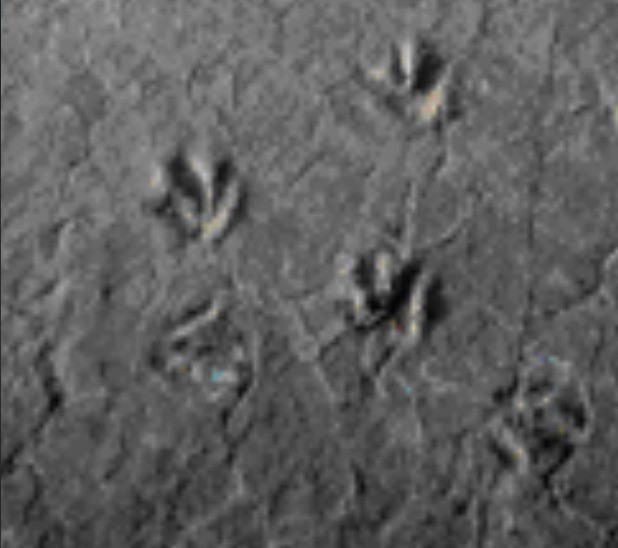
Note that the Dimetrodon pelycosaur, winged pterosaurs, aquatic ichthyosaurs, plesiosaurs, mosasaurs and other large prehistoric animals do not belong to the dinosaur family.
Eoraptor lunensis was a primitive species of dinosaur from Argentina that resembled, according to the studies of paleontologists, the common ancestor of all dinosaurs which was a small bipedal predator. Among the possible ancestors of dinosaurs there was Marasuchus, from the Middle Triassic of Argentina and soon after the little-known Saltopus of Scotland, the size of a hand, appeared.
During the reign of the dinosaurs, every land animal longer than 1 meter was a dinosaur. In the Humboldt Museum in Berlin there is the complete skeleton of the Brachiosaurus (now Giraffatitan), which belonged to the tallest (12 m) and heaviest (between 30 and 60 tons) dinosaur known so far, discovered in Tanzania between 1907 and 1912, The Diplodocus, which measures 27 m and which was discovered in Wyoming. It was mounted in the Carnegie Natural History Museum in Pittsburgh in 1907.
There were larger dinosaurs such as the massive Argentinosaurus, probably weighing 80–100 tons; the 40 m long Supersaurus and the tallest, the Sauroposeidon (18 m), which could have reached the sixth floor of a building but only a few bones were recovered.
Today the skeletons of various specimens have been assembled and placed in major international museums, thus becoming a unique and spectacular attraction but also part of the culture of the whole world.
Paleontological scientists believe that theropods, evolving, led to the appearance of the first birds.
The first fossil evidence left by dinosaurs on Italian soil to be recognized as such were the footprints found in 1989 and 1991 in Veneto and Trentino dating back between the Upper Triassic and the Lower Jurassic, i.e. the beginning of the Mesozoic era. These findings were followed by others such as the one that occurred in 1994 in Val di Putha near Claut by a group of students from a school in Padua.
Other fossil discoveries were made in the South, near Benevento: Scipionyx samniticus, a small carnivorous dinosaur. The discovery of Scipionyx is very notable for being a more unique than rare case of a dinosaur remains in which some parts of the internal organs are preserved.
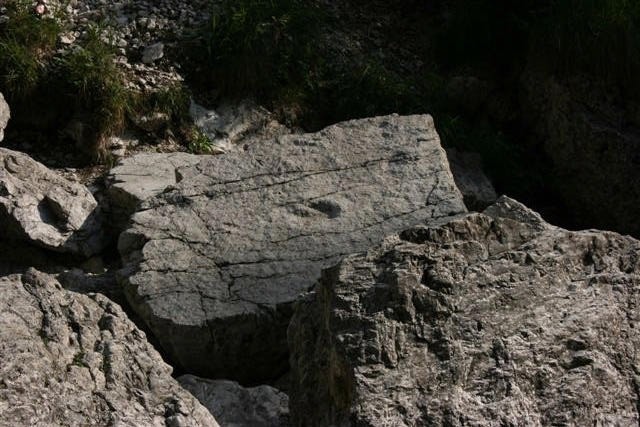
215 MILLION YEARS AGO
The rocks of the Friulian Dolomites Park were originated from sediments that were deposited over 215 million years ago, in an environment completely different from the current one. In ancient times, Friuli was a vast marine area with waters and emerged land similar to the much smaller one that can be observed today in Grado.
Morphology and climate were similar to those found today in the Bahamas. The layers of whitish sand and calcareous mud that were found (deposited) in these tidal flats due to compaction and cementation, were subsequently transformed into fossil footprints.

In their movements, the dinosaurs, across the tidal flats, passed along the coast, sinking their paws into the soft carbonate muddy marshes;

when the paw was lifted its imprint remained;

the footprint was filled and buried by sediment transported by tidal currents or storms;
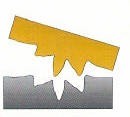
after the transformation of the sediment into layers of rock, the latter, removed, "exfoliated" so to speak by erosion and landslides, revealed the presence of the footprint or its filling.












